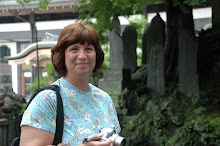
First Tomoko Yanagi spoke about her father's story. He was 14 years old and 5 miles away from the hypocenter in Hiroshima. He survived, but many of his family and friends did not. Yanagi spoke of the 400,000 people who lost their lives within 1 year of the bomb being dropped. She also talked about how the people of Korea saw dropping the bomb on Japan as a good action. The result was ending Japanese occupation of Korea when World War II was over. These were two facts I had never really though about, especially the ending of occupation of Korea after the war.
Next Keijiro Matsushima spoke to the room full of teachers. He was 16 years old then the bomb was dropped on Hiroshima. He was lucky that day. Students were urged to go back to school on August 1. During the war many students worked in factories instead of going to school. He chose to go back to school. This was just 6 days before the bomb was dropped.
The school was on the edge of Hiroshima. The bomb was dropped on an area of the city that had a large number of factories. Anything 1 to 3 miles from the hypocenter did not survive. He has always considered himself very lucky. Matsushima stated that people are "angry at the A-bomb, not at the people of the United States". This is a very strong statement symbolizing how we must live in peace and to forgive our enemies for the benefit all of people.
Why was the bomb so effective? Geography had a hub impact. Hiroshima is surrounded by mountains. This kept the radiation concentrated in the area where the bomb was dropped. However people returned to hiroshima within days of the bombing. A street car ran just 2 days after the bombing in a distant part of the city. Plants were growing again by the next summer. It took 10 years to rebuild the city.
Hiroshima Peace Memorial Museum and Park is located on the site the bomb was dropped. It is to remember the people who have lost their lives on the fateful day, but also to celebrate peace. A virtual tour of the site can be found at http://www.pcf.city.hiroshima.jp/ . I highly recommend viewing this site.
Learning about Hiroshima and Nagasaki will change the way you think about war, peace, and nuclear weapons. My thoughts have changed after listening to Keijiro Matsushima and Tomoko Yanagi.
Kabuki
The afternoon was spent learning about traditional Japanese theater called Kabuki presented by  Mark Oshima. This type of theater only has adult male performers, even the female parts are played by males. Kabuki dates back to the Edo Period (1603-1868). Live Kabuki theater is still very popular in Japan today. The themes are very complex, often having to do with historical disputes or love suicides. Kabuki theater is not intended for children as some of the topics are a little mature.
Mark Oshima. This type of theater only has adult male performers, even the female parts are played by males. Kabuki dates back to the Edo Period (1603-1868). Live Kabuki theater is still very popular in Japan today. The themes are very complex, often having to do with historical disputes or love suicides. Kabuki theater is not intended for children as some of the topics are a little mature.
 Mark Oshima. This type of theater only has adult male performers, even the female parts are played by males. Kabuki dates back to the Edo Period (1603-1868). Live Kabuki theater is still very popular in Japan today. The themes are very complex, often having to do with historical disputes or love suicides. Kabuki theater is not intended for children as some of the topics are a little mature.
Mark Oshima. This type of theater only has adult male performers, even the female parts are played by males. Kabuki dates back to the Edo Period (1603-1868). Live Kabuki theater is still very popular in Japan today. The themes are very complex, often having to do with historical disputes or love suicides. Kabuki theater is not intended for children as some of the topics are a little mature.
We also had a presentation on classical Japanese dance which started in what is considered the Modern Period (1868-present). Much of the modern music took on Western culture. Many music pieces were military marches, melodies and harmonies, or music for entertainment. We were honored with a dance presentation with music from the Modern Period.


No comments:
Post a Comment